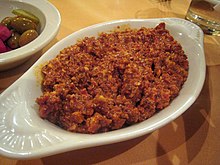Muhammara
 | |
| Course | Dip |
|---|---|
| Place of origin | Syria |
| Region or state | Levant |
| Main ingredients | Red peppers, walnuts, breadcrumbs, lemon juice, pomegranate molasses, red chili paste, salt, olive oil, cumin |
Muhammara (Arabic: محمرة "reddened") or mhammara is a spicy dip made of walnuts, red bell peppers, pomegranate molasses, and breadcrumbs. It is associated with Aleppo,[1] but can also be found in Turkey, especially in southeastern regions, where Arab dishes are more common in the local cuisine because of the Syrian cultural influence.[2] In Turkey, muhammara is referred to as acuka[3] and is served as part of the mezze platter appetizer course.[4]
Contents
Ingredients[]
The principal ingredients are usually fresh or dried peppers, usually Aleppo pepper, ground walnuts, breadcrumbs, and olive oil. It may also contain garlic, salt, lemon juice, pomegranate molasses, and sometimes spices (e.g. cumin).[5][6] It may be garnished with mint leaves or parsley.
Usage[]
Muhammara is eaten as a dip with bread, as a spread for toast, and as a sauce for kebabs, grilled meats, and fish.[5][7]
See also[]
- Ajika, a dip in Caucasian cuisine, based on a boiled preparation of hot red peppers, garlic, herbs and spices
- Ajvar, a condiment made principally from roasted peppers, eggplants, and sunflower oil or olive oil that is popular in Croatia, Bosnia, Serbia, and other Balkan cuisines
- Biber salçası, a hot or sweet pepper paste in Turkish cuisine
- Harissa, a hot chili pepper paste in Maghreb cuisine
- Sahawiq, a hot sauce in Middle Eastern cuisine, made from fresh hot peppers seasoned with coriander, garlic and various spices
- List of dips
- List of sauces
References[]
- ^ Wright, Clifford (2003). The Little Foods of the Mediterranean: 500 Fabulous Recipes for Antipasti, Tapas, Hors D'Oeuvre, Meze, and More. Harvard Common Press. p. 59. ISBN 9781558322271.
Arabs will reflexively tell you that the famous muḥammara comes from Aleppo.
- ^ Cornell, Kari; Turkoglu, Nurcay (2004). Cooking the Turkish Way: Culturally Authentic Foods Including Low-fat and Vegetarian Recipes.
- ^ Heather Arndt Anderson (2016). Chillies: A Global History. Reaktion Books. ISBN 9781780236827.
- ^ "Nefis acuka tarifi". Milliyet.com.tr.
- ^ a b Leah Koenig (2017). Little Book of Jewish Appetizers. Chronicle Books. ISBN 9781452163086.
- ^ "Muhammara". ottolenghi.co.uk. Retrieved 2020-09-29.
- ^ Muhammara Archived 2007-06-09 at the Wayback Machine
Condiments | ||
|---|---|---|
| ||
| Sauces |
|  |
| Dips | ||
| Pickles and preserves |
| |
| Spreads and pastes |
| |
| Oils and liquids |
| |
| Spices and powders |
| |
| Salads |
| |
| Salad dressings |
| |
| Ketchups |
| |
| Mustards |
| |
| Vinegars |
| |
| List articles |
| |
| Accoutrements | ||
Chili sauces, hot sauces, and chili pastes | ||||
|---|---|---|---|---|
| Chili sauce |
|  | ||
| Chili paste | ||||
| ||||
Jewish cuisine | |
|---|---|
| History |
|
| Types |
|
| Religious dietary laws and related terms |
|
| Chefs |
|
| Religious foods |
|
| Ashkenazi breads |
|
| Sephardi and Mizrahi breads |
|
| Ethiopian Jewish breads |
|
| Bagels and similar breads |
|
| Pancakes |
|
| Cakes and other desserts |
|
| Cookies |
|
| Pastries | |
| Fried foods |
|
| Dumplings, pastas and grain dishes |
|
| Casseroles and savory baked dishes | |
| Snacks and other baked goods |
|
| Sandwiches |
|
| Egg dishes |
|
| Meat dishes |
|
| Fish dishes |
|
| Salads and pickles |
|
| Vegetable dishes |
|
| Soups and stews |
|
| Cheeses and other dairy products |
|
| Condiments, dips and sauces |
|
| Beverages |
|
| Herbs, spices and seasonings |
|
| Related lists |
|
| |
| |
|---|---|
| Beverages |
|
| Breads |
|
| Appetizers and salads |
|
| Dairy products |
|
| Soups and stews |
|
| Pastries |
|
| Dishes |
|
| Grilled meats |
|
| Desserts |
|
| Unique instruments |
|
| Related cuisines |
|
| |
Lebanese cuisine | |
|---|---|
| Beverages |
|
| Breads |
|
| Meze |
|
| Cheeses |
|
| Soups |
|
| Dishes |
|
| Grilled meats |
|
| Desserts |
|
| Frequent ingredients |
|
| Unique instruments |
|
| Related cuisines |
|
Turkish cuisine | |
|---|---|
| Beverages |
|
| Breads |
|
| Appetizers and salads |
|
| Cheeses |
|
| Soups |
|
| Dishes |
|
| Grilled meats |
|
| Desserts |
|
| Frequent ingredients |
|
| Unique instruments |
|
| Related cuisines |
|
| |
- Dips (food)
- Levantine cuisine
- Meze
- Spicy foods
- Vegan cuisine
- Turkish vegetarian cuisine
- Webarchive template wayback links
- Articles with short description
- Short description is different from Wikidata
- Articles containing Arabic-language text